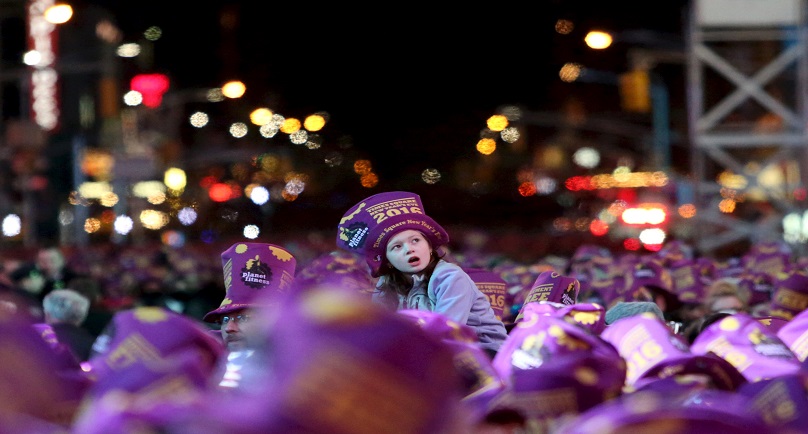Image: A child is lifted above the crowd during New Year celebrations in Times Square in the Manhattan borough of New York December 31, 2015. REUTERS/Andrew Kelly
By Laila Kearney
NEW YORK (Reuters) – More than a million people in New York’s Times Square hailed the arrival of 2016 early Friday with kisses, cheers and a measure of relief as America’s biggest New Year’s Eve celebration unfolded without a hitch under a blanket of unprecedented security.
The transition to the new year was marked by the descent of the traditional lighted crystal ball from atop a skyscraper at the center of the famed Manhattan crossroads, the climax of an annual rite of winter dating back to 1904.
With memories of the deadly attacks in Paris and California still fresh, police took extraordinary measures to ensure security at a gathering that has come to define the New York experience for many visitors to the largest U.S. city.
But the event, broadcast live on national television, went off without a hint of trouble, as a festive mood prevailed despite – or perhaps because of – the heavy police presence.
“This is the center of the world on New Year’s Eve,” said Rick Milley, 60, who traveled from Boston with his wife, Debbie, 59, to ring in the new year in Times Square.
“This was on our bucket list,” Debbie Milley said as the couple took pictures of themselves using a selfie stick.
The pair have spent the holiday in New York before but never before in Times Square, a year-round tourist draw, filled with chain stores, family restaurants and flashy advertising displays.
About 6,000 uniformed and undercover police officers, 500 more than last year, patrolled the area, with the force bolstered by mounted patrols, bomb-sniffing dogs, radiation detectors and hundreds of surveillance cameras.
For the first time on a New Year’s Eve, the city deployed its new Critical Response Command, which includes more heavily armed officers. The unit is trained to detect and respond to attacks, such those in Paris that killed 130 people on Nov. 13, or the rampage in San Bernardino, California, in which 14 were slain.
The U.S. Department of Homeland Security ranked the Times Square celebration as a level-2 concern on its five-point scale of security risks for major public events, a designation one’step below the top-rated level-1 classification given Friday’s upcoming Tournament of Roses Parade in Pasadena, California.
PENNED IN FOR THE PARTY
The famous New Year’s Eve ball, which is 12 feet (3.6 meters) in diameter and weighs nearly 6 tons, descended on a pole mounted on top of One Times Square, a narrow wedge of a building along 42nd Street at the southern end of the square.
Mayor Bill de Blasio pushed the button that began the descent, leading to the 60-second countdown to midnight, when a giant illuminated “2016” sign flashed on, signaling the beginning of the new year.
Crowds began assembling in Times Square hours before the official start of the festivities at 6 p.m. Thursday (2300 GMT), organized into neat pens formed by police barricades stretched for many blocks up Seventh Avenue and Broadway north of One Times Square.
From a vantage point about 20 floors above, the revelers appeared to be tucked neatly into block-long honeycombs encircled by uniformed officers and support workers dressed in bright red coveralls.
Cheers reverberated through the area as images from the entertainment stages played on a giant screen mounted on the building just below the pole supporting the crystal ball. On occasion, fireworks exploded above, sending flashes of light and wafts of smoke through the square.
“I always wanted to come here, but never took the chance,” said James Gomez, 39, of New Haven, Connecticut, as he surveyed the area with friends looking for a prime viewing spot.
Gomez came to Times Square even though he said he was concerned about the area being targeted in an attack. “I’m scared,” he said.
In the hours before midnight, musical artists such as Carrie Underwood and Jessie J performed on stages set up in the area.
More than 100 million Americans and 1 billion people worldwide were expected to watch the festivities on television.
In Rochester, New York, a 25-year-old man accused of planning to attack a restaurant on New Year’s Eve was arrested on Wednesday and charged with attempting to provide support to Islamic State, the U.S. Justice Department said.
Afterwards, Rochester, about 330 miles (530 km) northwest of New York City, canceled its New Year’s Eve fireworks display.
Before entering Times Square, visitors were required to pass through tight security checkpoints, with police stopping anyone from carrying backpacks and large bags while searching smaller bags and scanning people with metal detectors.
The tradition of gathering in Times Square to celebrate the new year began in 1904, according to the Times Square Alliance, the area’s business-development association.
That was the year that the New York Times opened a new headquarters building at One Times Square and the city officially renamed the square after the newspaper.
Other pictures of the new year celebrations in New York’s Times Square:
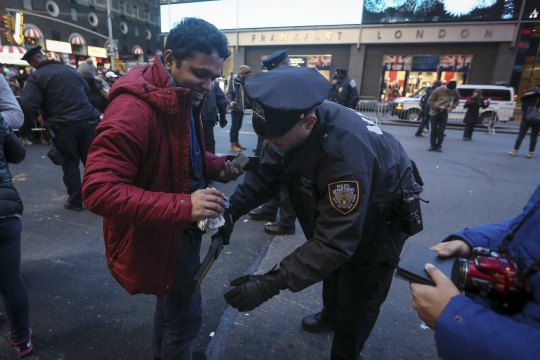
A man is scanned with a wand by a member of the New York Police Department as he tries to enter a penned area of Times Square during New Year’s Eve celebrations in the Manhattan borough of New York December 31, 2015. REUTERS/Carlo Allegri
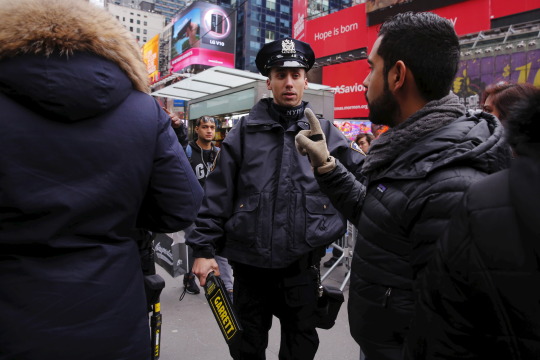
A New York Police Department officer speaks with revelers as they wait for the beginning of New Year’s Eve festivities in the Times Square area of New York December 31, 2015. REUTERS/Lucas Jackson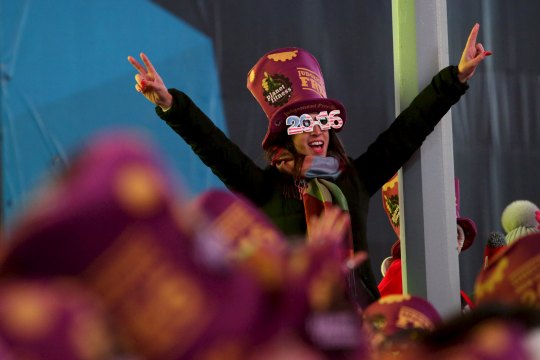
A woman cheers during New Year celebrations in Times Square in the Manhattan borough of New York December 31, 2015. REUTERS/Andrew Kelly
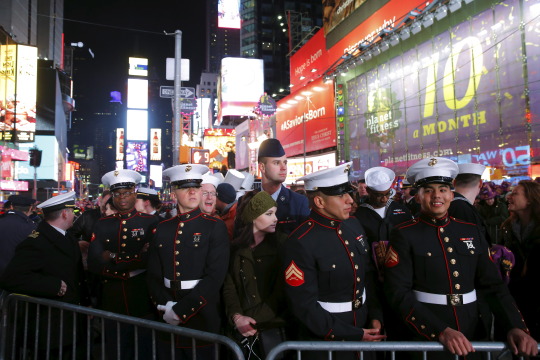
Members of the United States Armed Forces stand behind barriers during New Year’s Eve celebrations at the Times Square area of New York, December 31, 2015. REUTERS/Lucas Jackson
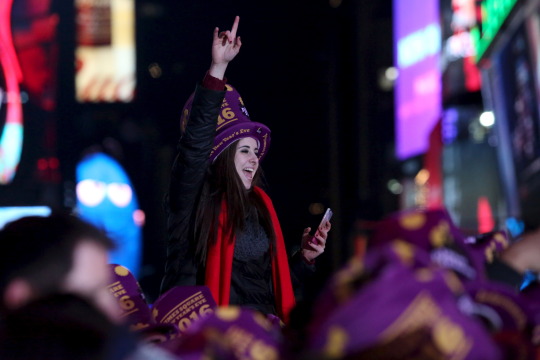
A woman cheers during New Year celebrations in Times Square in the Manhattan borough of New York December 31, 2015. REUTERS/Andrew Kelly
(Additional reporting by Steve Gorman from Los Angeles and Frank McGurty in New York; Writing by Frank McGurty; Editing by Jonathan Oatis, Robert Birsel)
Copyright 2015 Thomson Reuters. Click for Restrictions.


